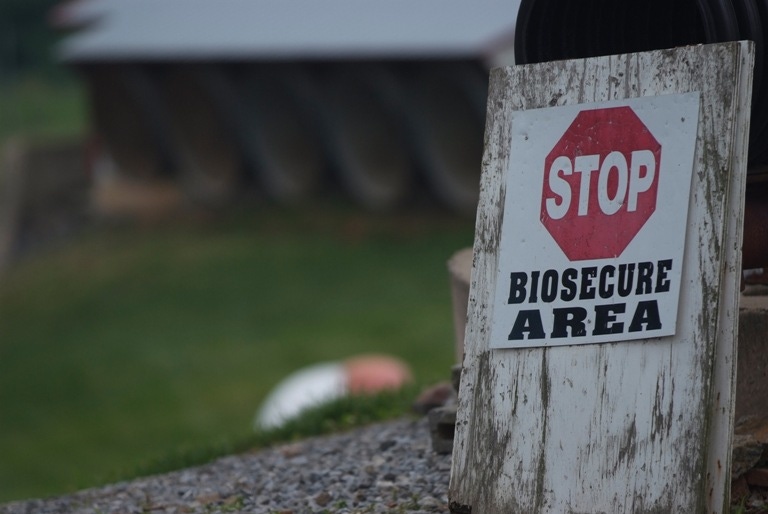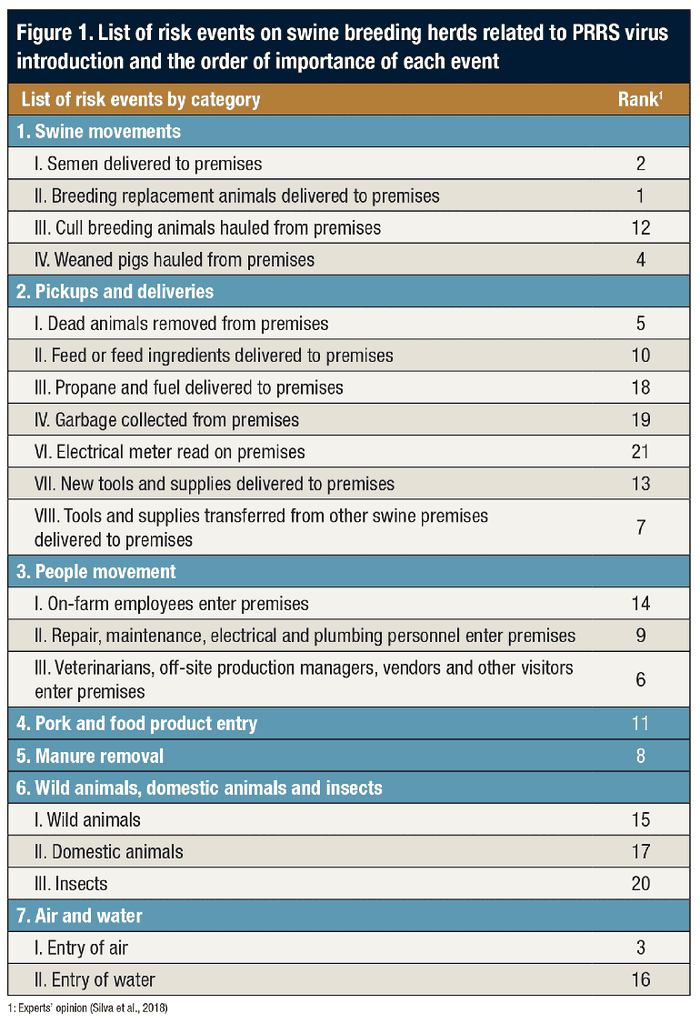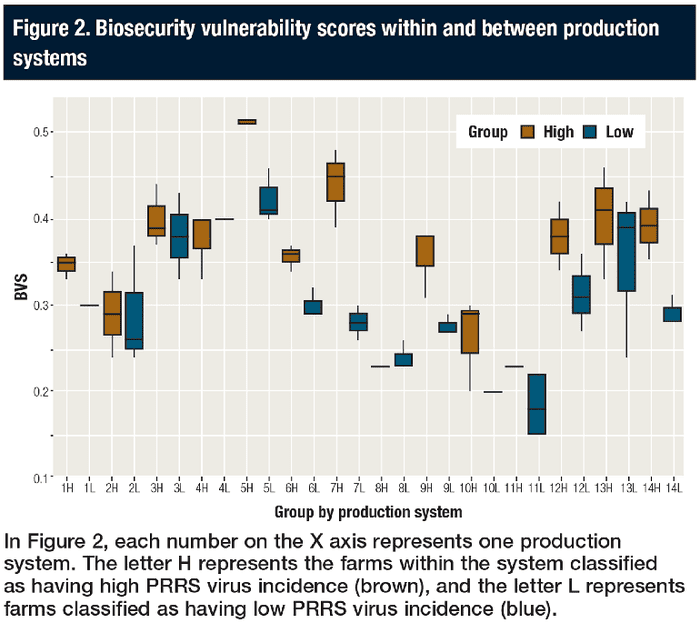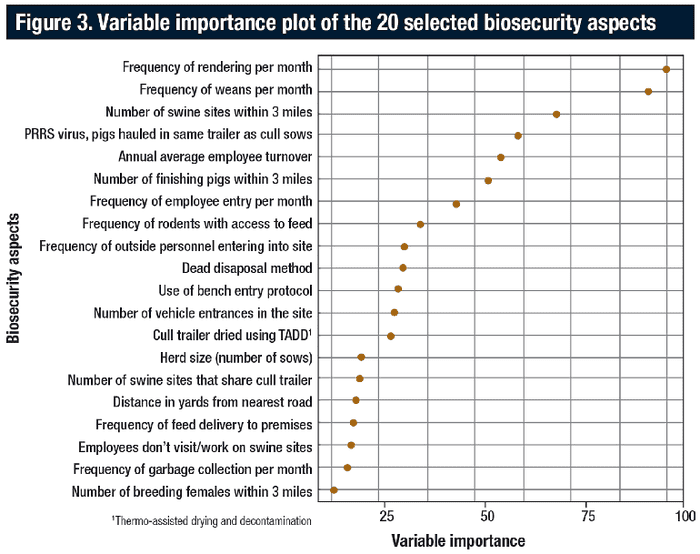Biosecurity at your hands: Measure risks to control losses
Blueprint: To minimize disease transmission, swine producers and veterinarians adopt biosecurity and management practices at the herd level to control and prevent the occurrence of diseases.
October 10, 2018

By Gustavo S. Silva, Derald J. Holtkamp, Chris J. Rademacher, Alejandro Ramirez, Locke Karriker and Daniel C.L. Linhares, Iowa State University College of Veterinary Medicine Veterinary Diagnostic and Production Animal Medicine Department
The U.S. swine industry over the last few years has made changes in animal production, with an increased focus on profitability and efficiency. This motivation of increasing profit and minimizing losses, combined with technological developments, such as the use of more productive genetic lines, larger herds and a shift to multisite production, has drastically changed swine production.
Although these changes make herds more profitable, they have also led to health challenges given the concentration of animals in some regions, evolving interaction between host and pathogens, and the complex relationship between different production sites.
Disease is always a concern for the swine industry, and it affects herd profitability by not allowing pigs to express their full genetic potential. To minimize disease transmission, swine producers and veterinarians adopt biosecurity and management practices at the herd level to control and prevent the occurrence of diseases.
Biosecurity in swine farms is the combination of all practices taken to reduce the risk of introduction and spread of disease. In other words, biosecurity can be viewed as a way to keep diseases out of the farm, as well as ways to control diseases already in the farm. Biosecurity can be grouped into three buckets: bioexclusion, biomanagement and biocontainment.
Bioexclusion is the combination of protocols that prevent a new pathogen introduction (e.g., shower in and out, monitor health status of gilts prior to entry). Biocontainment is those protocols to prevent escape of disease agents to neighboring pig populations (e.g., cleaning and disinfection of shared supplies). Biomanagement means practices applied to control and manage those disease agents already present (e.g., adoption of McREBEL (Management changes to Reduce Exposure to Bacteria to Eliminate Losses) protocol, all-in all-out) (CSHB, 2010).
In the past, biosecurity protocols were recommended in the form of long lists, but this approach proved ineffective and pathogens spread throughout the country. Since porcine reproductive and respiratory syndrome virus was detected, and in 2013 when porcine epidemic diarrhea virus was introduced in the U.S., the definition of applied biosecurity has been evolving.
Disease introduction risk can never be completely eliminated, but every farm and its employees should understand the risks of disease introduction associated with the farm’s practices. Different diseases can be introduced into a herd in different ways every day, so when developing a biosecurity protocol, it is more about identifying critical control points to break the transmission chain of the pathogen in order to reduce the pathogens load that may contact pigs.
This article focuses on bioexclusion (practices to mitigate risk of pathogen introduction into herds), and we will use PRRS virus to demonstrate our approach to assess and quantify herd vulnerabilities to pathogen introduction. PRRS virus still remains a challenge in the U.S. swine industry, causing substantial economic losses due to significant changes in productivity (Holtkamp et al., 2013).
First, we will revisit how PRRS virus can be introduced into a herd. Then, we will describe our approach to identify gaps on bioexclusion protocols. Finally, we will demonstrate how biosecurity benchmarking can help producers identify vulnerabilities among herds and identify their risks. This comprehensive approach can help producers, or decision-makers, set priorities for improving and monitoring biosecurity practices over time. In addition, this same concept can be applied to other pathogens.
Understanding PRRS virus
PRRS virus can be transmitted between farms via different risk events including swine movements, pickup and deliveries of supplies to or from farms, people movement, contact with other animals, air and water (Otake et al., 2002; Zimmerman et al., 2012). Risk events occur when carrying agents enter the herd. Carrying agents are defined as anything that may be contaminated or infected with PRRS virus that can be brought onto the farm: e.g., semen, a livestock trailer, a vehicle and driver, tools and supplies (Holtkamp and Linhares, 2017).
For a herd to become contaminated, a series of failures on biosecurity protocols must occur. In this way, first identifying the risk events that occur in the farm and then focusing on the carrying agents makes it easier to understand the purpose of each biosecurity practice and identify the protocol gaps. A comprehensive list of risk events on most swine breeding farms is included in Figure 1.

Another point that must be taken into account is the frequency of risk events. For example, the introduction of replacement females into the herd is a high-risk event; however, it occurs at a lower frequency compared to employee entry, which is perhaps a lower-risk event but occurs several times a day.
These differences should also be taken into consideration when communicating with all farm employees, so they understand the importance of ensuring protocol efficacy.
Measuring herd vulnerabilities
Herd-specific biosecurity assessments are useful to determine how PRRS virus may be introduced in swine herds, and once you identify and quantify the magnitude of gaps, you can make risk-based decisions. Also, a comprehensive survey is useful for identifying gaps or establishing the most likely causes of virus introduction after an outbreak.
For this purpose, we developed and validated a biosecurity vulnerability score that represents the relative vulnerability of swine breeding herds to PRRS virus introduction (Silva et al., 2018). To organize the model, a multicriteria decision analyses structure was used to order the category of risk events and carrying agents (Silva et al., 2017).
The model takes into consideration all PRRS virus transmission routes and incorporates the relative importance (rank) among each category, risk event and carrying agent. The relative importance between risk events was obtained using experts’ opinions. The ranking of importance for each risk event can be observed in Figure 1.
A survey was used to assess the biosecurity practices that were implemented at the herd level, and included questions about bioexclusion practices for each carrying agent. The survey was developed through the PRRS Outbreak Investigation Program, funded by the Iowa Pork Producers Association (Canon et al., 2015). Data from the survey were used to calculate a biosecurity vulnerability score (BVS) ranging from 0 to 1, with the closer the score is to 1 meaning the greater the vulnerability of the herd to PRRS virus introduction.
To validate the scores, a case-control study was performed, with the objective to test the hypothesis that biosecurity scores differ between farms that had a relatively low incidence of PRRS virus outbreaks (control herds), compared to farms that had a relatively high incidence (case herds) (Baker et al., 2018). Also, the score helps to identify the most likely routes of PRRS virus introduction.
Each production system was asked to rank eligible breeding herds according to the number of PRRS virus outbreaks in the last three years. The farms were ranked based on the number of PRRS virus outbreaks by system; farms below the 25th percentile were classified as relatively low PRRS virus incidence (control herds), and farms above the 75th percentile were classified as relatively high PRRS virus incidence (case herds).
A total of 84 herds were enrolled from 14 production systems. The herds within the case group (high incidence) had an average of three PRRS virus outbreaks in the past three years (range 2-6); in the control group, almost no herds had an outbreak in the past three years.
The BVS was statistically different between groups (p <0.003). BVS for herds with a low incidence of PRRS virus outbreaks ranged from 0.12 to 0.46, with a mean of 0.30. BVS from the case group varied between 0.20 (lower vulnerability) and 0.52 (higher vulnerability), with a mean of 0.35. Figure 2 describes the results by group within production systems, and it can be observed that there is a large difference between groups (low versus high) within a production system: farms with higher incidence of PRRS virus outbreaks consistently had higher vulnerability.

This score can help identify the differences in vulnerabilities within production systems, and it suggests the category of risk event or even the risk event that most influenced the value of the BVS. For example, the results suggest that most farms in the control group had greater vulnerability to PRRS virus transmission through air and water. In contrast, most of the farms in the case group demonstrated higher vulnerability to transmission by swine movements.
This information can be helpful to look more in-depth into the protocols used in each herd, and this tool can help producers or decision-makers set priorities for improving and monitoring biosecurity practices over time.
Comprehensive biosecurity assessments are great for identifying biosecurity gaps and generating the BVS. Those assessments may take up to two hours per herd to be completed. Thus, some producers have asked for simplified biosecurity assessments to provide a quick glance at vulnerability using a minimum number of questions that can be used between comprehensive evaluations.
Therefore, our group has been exploring other tools to identify the bioexclusion aspects often associated with farms that have been having outbreaks year after year. Reducing the number of questions asked may facilitate the process to obtain data from farms, which makes benchmark biosecurity aspects over time possible.
Benchmarking biosecurity
Benchmarking has proven to be one of the best tools to improve productivity in different sectors. Benchmarking may motivate improving performance by comparing scores with peers, learning from others and identifying actions that need to be taken.
Benchmarking biosecurity aspects facilitates the identification of common mistakes between farms that have had outbreaks, and, similarly, identifies common aspects in farms that keep themselves free of PRRS virus introduction over time.
With this purpose, this second tool (currently under development) aims to identify a minimum set of biosecurity aspects that, when combined, have a strong association with the likelihood of PRRS virus introduction into swine breeding herds. The biosecurity aspects of each breeding herd are being assessed using a biosecurity survey with questions about herd demographics, swine density, PRRS virus history, frequency of risk events and biosecurity practices.
Preliminary analyses are done by comparing the biosecurity aspects between farms with and without PRRS virus outbreaks through a set of machine-learning algorithms. This ongoing project is a collaboration with North Carolina State University (Gustavo Machado).
The preliminary model selected 20 variables by their importance in classifying farms that had or did not have PRRS virus outbreaks. The best performance model was obtained using Random Forest algorithm, and the model was able to classify the farms with an accuracy of 80%. These variables were related to the frequency of events at farms, herd type, hog density around the farm, employee turnover, use of the same trailer within production system and type of dead animal disposal. The variables in order of importance can be observed in Figure 3.

Using the model, we can also obtain the positive predicted value for each farm classified within a PRRS virus outbreak group. In this data set, the predicted positive value showed a strong positive correlation (r = 0.766, p-value <0.001) with the frequency of past outbreaks.
This model can be used to evaluate the vulnerability of a herd to experience a PRRS virus outbreak based on the farm’s biosecurity aspects, but more analyses have to be done with a larger sample size to be representative. The preliminary analysis seems to identify the number of rendering visits per month and the number of wean pig shipments per month as the biosecurity variables carrying the most risk.
The results prove the concept that there is correlation in biosecurity aspects of swine breeding herds. In other words, it is possible to measure and compare the biosecurity vulnerability of swine sites by asking just a few questions. The 20 selected practices have proven to be important in classifying the herds investigated, but a larger sample size is needed to continue investigating these relationships.
The reduction in the number of questions asked does not exclude the importance of applying the other biosecurity practices but can be an alternative to benchmark biosecurity aspects over time.
Conclusion
Understanding risk events and how pathogens are introduced on farms is the first step to establishing biosecurity protocols. These tools can help producers and veterinarians measure and benchmark biosecurity vulnerability, identify sites at relatively higher (or lower) risk of PRRS virus introduction and set priorities to manage the risk of PRRS virus introduction.
References
Baker, K.L., Silva, G., Morrison, R., Vilalta, C., Holtkamp, D., Linhares, D., 2018. Comparison of biosecurity aspects between swine breeding herds with low and high incidence of porcine reproductive and respiratory syndrome virus outbreaks, in: 49th Annual Meeting of the American Association of Swine Veterinarians. p. 80.
Canon, A., Gerardy, K., Karriker, L., Holtkamp, D., 2015. Outbreak Investigation Program — A Systematic Approach to PRRS Outbreak Investigations., in: Proc. 2015 North American PRRS Symposium. Chicago.
Canadian Swine Health Board, 2010. National Swine Farm-Level Biosecurity Standard. Can. Swine Heal. Board.
Holtkamp, D., Linhares, D., 2017. Understanding how pathogens infect pig farms, in: 48th AASV Annual Meeting. American Association of Swine Veterinarians, Denver.
Holtkamp, D.J., Kliebenstein, J.B., Neumann, E.J., Zimmerman, J.J., Rotto, H.F., Yoder, T.K., Wang, C., Yeske, P.E., Mowrer, C.L., Haley, C. a., 2013. An assessment of the economic impact of the porcine reproductive and respiratory syndrome virus on United States pork producers. J. Swine Heal. Prod. 21, 72–84.
Otake, S., Dee, S., Pijoan, C., 2002. Transmission of PRRSV: Recent research reports. Int. Pigletter 22, 37; 40-42.
Silva, G., Corbellini, L.G., Linhares, D., Baker, K.L., Holtkamp, D., 2018. Development and validation of a scoring system to assess the relative vulnerability of swine breeding herds to the introduction of PRRS virus. Prev. Vet. Med.
Silva, G.S., Holtkamp, D.J., Linhares, D.C.L., 2017. Assessing anti-PRRSV biosecurity, in: 48th AASV Annual Meeting. American Association of Swine Veterinarians., Denver.
Zimmerman, J.J., Benfield, D., Dee, S.A., Murtaugh, M.P., Stadejek, T., Stevenson, G.W., Torremorell, M., 2012. Porcine Reproductive and Respiratory Syndrome Virus (Porcine Arterivirus), in: Zimmerman, J.J., Karriker, L.A., Ramirez, A., Schwartz, K.J., Stevenson, G.W. (Eds.), Diseases of Swine. Wiley-Blackwell, pp. 461–486.
You May Also Like



